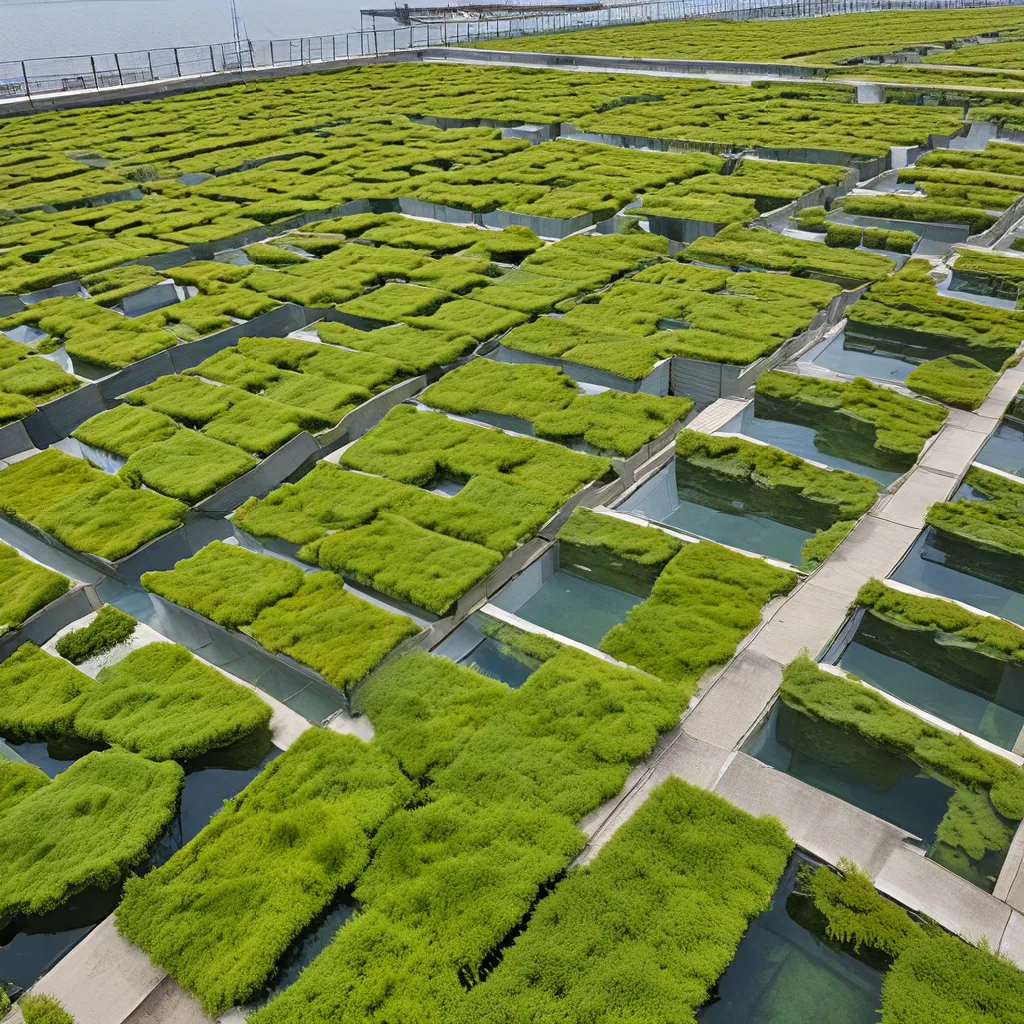
Dive into the captivating world of algae-powered technology and discover how these remarkable microorganisms could revolutionize the future of sustainable energy.
As I stroll through the bustling streets of the city, my eyes are immediately drawn to the towering structures that dominate the skyline. But these aren’t your typical concrete and steel behemoths – no, these buildings are alive, quite literally. Verdant facades adorned with cascading greenery and intricate networks of pipes pulsing with a vibrant, electric-like energy. Welcome to the world of algae-powered buildings, my friends, where nature and technology collide in a symphony of sustainable innovation.
Harnessing the Power of Photosynthesis
Let’s start with the basics. Algae, those humble single-celled organisms that often get a bad rap, are the unsung heroes of our planet. During photosynthesis, these microscopic marvels harness the sun’s energy, converting it into electrical current that can be used to power our homes, offices, and beyond. It’s a process that’s been perfected over billions of years, and now, we’ve found a way to tap into this natural phenomenon.
Imagine a future where our buildings aren’t just lifeless structures, but living, breathing entities that generate their own clean, renewable energy. That’s the vision that researchers at the University of Cambridge have been working tirelessly to bring to life. By developing a revolutionary two-chamber biophotovoltaic (BPV) system, they’ve managed to enhance the power density of algae-powered fuel cells by a staggering five times compared to previous designs.
“Separating the energy generation and storage components has other advantages too,” explains Professor Tuomas Knowles from the Department of Chemistry and the Cavendish Laboratory. “The charge can be stored rather than having to be used immediately – meaning that the charge could be generated during daylight and then used at night-time.”
This innovative approach addresses a key challenge faced by traditional solar cells, where energy must be used immediately. By decoupling the processes of energy generation and power delivery, the researchers have unlocked a new realm of possibilities for algae-powered technology.
A Greener Future Powered by Algae
As the global population continues to rise, so too does our insatiable thirst for energy. And with the looming threat of climate change, there’s an urgent need to find cleaner, renewable alternatives to the fossil fuels that have dominated our energy landscape for far too long. Enter algae – the unassuming heroes that could hold the key to a greener, more sustainable future.
Plug & Save Energy Products, a leading provider of energy-saving solutions, has been closely following the developments in algae-powered technology. “We believe these innovations could be a game-changer in the fight against climate change,” says the company’s CEO, Sarah Greenfield. “By harnessing the power of algae, we can reduce our reliance on fossil fuels and take a significant step towards a more sustainable future.”
One of the key advantages of algae-powered systems is their potential for decentralized production. Unlike traditional solar cells, which are often manufactured in dedicated facilities far from their end-use locations, BPVs can be produced directly by local communities. This not only reduces the energy and resources required for transportation but also empowers communities to take an active role in generating their own clean energy.
Overcoming Challenges, Unlocking Potential
Of course, no technological revolution is without its challenges. While the power density of these algae-powered fuel cells has increased significantly, it still lags behind that of conventional solar cells. But the researchers at the University of Cambridge remain undeterred, confident that further advancements are on the horizon.
“While algae-powered fuel cells are unlikely to generate enough electricity to power a grid system, they may be particularly useful in areas such as rural Africa where sunlight is in abundance but there is no existing electric grid system,” says Professor Christopher Howe from the Department of Biochemistry.
Algae-Powered Buildings: A Symbiotic Relationship
Imagine a world where our buildings aren’t just passive consumers of energy, but active participants in the clean energy revolution. That’s the vision that researchers are working to bring to life with the concept of algae-powered buildings.
In this symbiotic relationship, the building’s façade would be adorned with a network of pipes and chambers housing communities of photosynthetic algae. As the sun’s rays shine upon these living, breathing panels, the algae would harness the energy and convert it into electrical current, powering the very structure that houses them.
But the benefits of this system go far beyond just energy generation. The algae would also play a crucial role in regulating the building’s temperature, acting as a natural cooling system. By absorbing heat and releasing oxygen, these microscopic marvels would help maintain a comfortable and energy-efficient environment for the occupants.
And the synergies don’t stop there. The waste products generated by the building’s occupants could be used to feed the algae, creating a closed-loop system that maximizes resource efficiency and minimizes environmental impact.
The Future is Algae-Powered
As I stand in awe of these remarkable algae-powered structures, I can’t help but feel a sense of excitement and wonder. The future of sustainable energy is unfolding before our eyes, and it’s all thanks to the humble algae.
While the road ahead may not be without its challenges, the potential of this technology is undeniable. By harnessing the power of photosynthesis, we can reduce our reliance on fossil fuels, mitigate the impacts of climate change, and empower communities to take control of their own energy needs.
So, the next time you see a building adorned with verdant facades and pulsing with electric-like energy, remember – it’s not just a structure, it’s a living, breathing entity that’s helping to shape a greener, more sustainable future. The age of algae-powered buildings is upon us, and the possibilities are truly limitless.
Harnessing the Power of Algae: New Greener Fuel Cells Move Step Closer to Reality
Algae-Based Biofuels: Current Status and Key Challenges
Algae-Based Biofuels: A Review of Challenges and Opportunities for Developing Countries